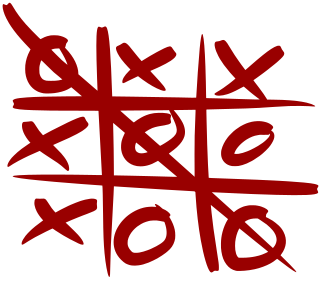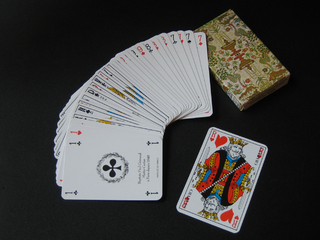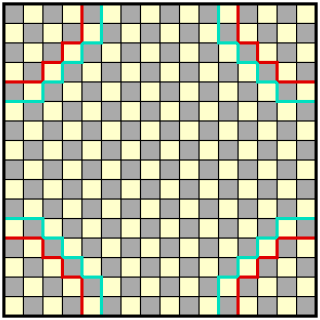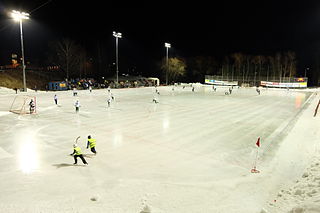Related Research Articles

Tic-tac-toe, noughts and crosses, or Xs and Os is a paper-and-pencil game for two players who take turns marking the spaces in a three-by-three grid with X or O. The player who succeeds in placing three of their marks in a horizontal, vertical, or diagonal row is the winner. It is a solved game, with a forced draw assuming best play from both players.
Chess strategy is the aspect of chess play concerned with evaluation of chess positions and setting goals and long-term plans for future play. While evaluating a position strategically, a player must take into account such factors as the relative value of the pieces on the board, pawn structure, king safety, position of pieces, and control of key squares and groups of squares. Chess strategy is distinguished from chess tactics, which is the aspect of play concerned with the move-by-move setting up of threats and defenses. Some authors distinguish static strategic imbalances, which tend to persist for many moves, from dynamic imbalances, which are temporary. This distinction affects the immediacy with which a sought-after plan should take effect. Until players reach the skill level of "master", chess tactics tend to ultimately decide the outcomes of games more often than strategy. Many chess coaches thus emphasize the study of tactics as the most efficient way to improve one's results in serious chess play.

The game of go has simple rules that can be learned very quickly but, as with chess and similar board games, complex strategies may be employed by experienced players.

Piquet is an early 16th-century plain-trick card game for two players that became France's national game. David Parlett calls it a "classic game of relatively great antiquity... still one of the most skill-rewarding card games for two" but one which is now only played by "aficionados and connoisseurs."

Halma is a strategy board game invented in 1883 or 1884 by George Howard Monks, an American thoracic surgeon at Harvard Medical School. His inspiration was the English game Hoppity which was devised in 1854.

Thirty-one or Trente et un is a gambling card game played by two to seven people, where players attempt to assemble a hand which totals 31. Such a goal has formed the whole or part of various games like Commerce, Cribbage, Trentuno, and Wit and Reason since the 15th century. 31 is popular in America and Britain.

3D tic-tac-toe, also known by the trade name Qubic, is an abstract strategy board game, generally for two players. It is similar in concept to traditional tic-tac-toe but is played in a cubical array of cells, usually 4×4×4. Players take turns placing their markers in blank cells in the array. The first player to achieve four of their own markers in a row wins. The winning row can be horizontal, vertical, or diagonal on a single board as in regular tic-tac-toe, or vertically in a column, or a diagonal line through four boards.

Tag is a playground game involving one or more players chasing other players in an attempt to "tag" and mark them out of play, usually by touching with a hand. There are many variations; most forms have no teams, scores, or equipment. Usually, when a person is tagged, the tagger says, "Tag, you're 'It'!" The last one tagged during tag is "It" for the next round. The game is known by other names in various parts of the world, including "running and catching" in India and "catch and cook" in the Middle East.

A face-off is the method used to begin and restart play after goals in some sports using sticks, primarily ice hockey, bandy, floorball, broomball, rinkball, and lacrosse.

Indoor American football, or arena football, is a variation of gridiron football played at ice hockey-sized indoor arenas. While varying in details from league to league, the rules of indoor football are designed to allow for play in a smaller arena. It is distinct from traditional American or Canadian football played in larger domed or open-air stadiums, although several early college football games contested on full-sized or nearly full-sized fields at Chicago Coliseum (1890s) and Atlantic City Convention Center helped to show that football could be played as an indoor game.
Guild Wars is an online role-playing game franchise developed by ArenaNet and published by NCSOFT. The games were critically well received and won many editor's choice awards, as well as awards such as Best Value, Best Massively Multiplayer Online Role-Playing Game (MMORPG), and Best Game. Guild Wars was noted for being the "first major MMO to adopt a business model not based on monthly subscription fees", its instanced approach to gameplay, and the quality of the graphics and play for computers with low specifications. In April 2009, NCSoft announced that 6 million units of games in the Guild Wars series had been sold. The sequel and fourth major entry into the series, Guild Wars 2, was announced in March 2007 and released on August 28, 2012. It features updated graphics and gameplay mechanics, and continues the original Guild Wars tradition of no subscription fees. The Guild Wars series had sold 11.5 million copies by August 2015

Bourré is a trick-taking gambling card game primarily played in the Acadiana region of Louisiana in the United States of America. It is also played in the Greek island of Psara, with the name Boureki. The game's closest relatives are probably Spades and Euchre; like many regional games, Bourré sports many variant rules for both play and betting considerations.
Sir Tommy, also called Old Patience, is a patience or solitaire card game using a single pack of 52 playing cards. It is said to be the ancestor of all patiences, hence its alternative title. It is a half-open, planner type of patience game in the same family of card-building games as Calculation and Strategy. It is also known as Try Again and Numerica.

Kings in the Corner, or King's Corners is a multi-player patience or solitaire-style card game for two to four players using a standard 52-card pack with the aim of each player to get rid of all the cards in their hand.
Puss in the Corner, also called Puss in Corner is a patience or solitaire card game that is played with a single pack of 52 playing cards. It is of the half-open, planner type and is a "thinly disguised variant of Sir Tommy," but with modifications and with the waste piles placed at the corners of the foundations, hence the name. It has the rare feature that the suits are built up in colour, not in suit.
Four corners is a children's game, often played in elementary schools. The object of the game is for players to choose corners of the room and not get caught by the designated "It" player until they are the last remaining participant.
Traditional Filipino games or indigenous games in the Philippines are games that have been played across multiple generations, usually using native materials or instruments. In the Philippines, due to limited resources for toys, children usually invent games without needing anything but players.There are different kinds of Philippine Traditional Games that are suited for kids, and the games also stand as one of the different culture and/or traditional games of the Philippines. These games are not only fun to play, but these games are also good for you. This is because different games require different skills. These games are also an important part in Filipino culture.

A bandy field or bandy rink is a large ice rink used for playing the team winter sport of bandy. Being about the size of a football pitch, it is substantially larger than an ice hockey rink.

Star Wars: Galaxy of Heroes is a mobile collectible RPG game. The game received a soft launch in Australia during October 2015, and was formally released on November 24, 2015.
References
- Boys' Own Book; a Complete Encyclopedia of Athletic, Scientific, Outdoor and Indoor Sports. With Illustrations. New York: James Millier, Publisher. 1881.
 This article incorporates text from this source, which is in the public domain .
This article incorporates text from this source, which is in the public domain .